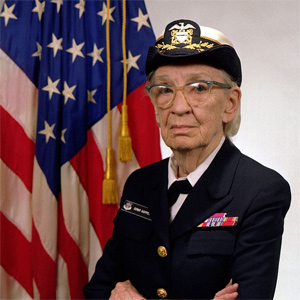 NEWS
NEWS
 NEWS
NEWS
 NEWS
NEWS
![]() Last Monday, Google took the opportunity to celebrate the 107th birthday of Grace Hopper, the pioneer computer scientist who gave us COBOL and the term “debugging.”
Last Monday, Google took the opportunity to celebrate the 107th birthday of Grace Hopper, the pioneer computer scientist who gave us COBOL and the term “debugging.”
She is much more than just a superb mathematical talent; it was Grace Hopper who helped teach the machines a language, stopped them from speaking in undecipherable numbers, enabled them to speak in English or French or German or whatever language you choose.
Grace Murray Hopper was born in 1906 as a child of an insurance broker in New York. Her family placed great emphasis on a good education. While her mother was more interested in mathematics, her father was more inclined to literature.
Curious and interested in science from early age, Hopper gets her license in mathematics and physics and joined Yale University, where she graduated from a master’s degree in mathematics. Two years later, she married to the professor of the University of New York, Vincent Foster Hopper, and decided to start teaching at Vassar College while continuing to Yale University to prepare her doctorate.
After teaching mathematics at Vassar College, this brilliant woman received a doctorate in mathematics in 1934 at Yale University. In 1943, she became involved in the U.S. Navy and is assigned to the team of Howard Aiken to work on the Harvard Mark I. It is then she started to work on programming language. At the end of the Second World War, she left active service in the navy, but continues to work on developing computers Harvard Mark II and Mark III.
Mother of Computing
In 1952, Grace wrote the first computer compiler. Before compilers, programming code was machine-specific, and therefore was very difficult to distribute and write. Grace believed that programming should be simple. According to Navy.mil, hopper believed that programming did not have to be a difficult task. Since computers only read binary codes, a series of 0s and 1s placed in a certain order that the computer understands, she believed that programs could be written in English and then translated into binary code.
Grace Hopper therefore gives a turning point in the world of the computer, as it states that the program can be written in a different way with the machine language. From this idea, COBOL, the first user-friendly business computer software program, was born in 1959. Hopper served as the technical consultant to the committee that defined COBOL — whose specification was inspired by the FLOW-MATIC language developed under her.
Later, Hopper invested a great deal of time advocating validation procedures to bring about the international standardization of computer languages. She won numerous awards for her career. In 1969, she was awarded the first ever Computer Science Man-of-the-Year Award from the Data Processing Management Association. In 1971, the Sperry Corporation initiated an annual award in her name to honor young computer professionals for their significant contributions to computer science.
She was first one ever to use the expression “bug” to describe a computer malfunction or software problem. In 1947, something went haywire in one of the Mark system and later it was discovered that a dead moth in the wiring. From that point on, Hooper said, if something went wrong with the system, everyone said “it has a bug in it.”
Hopper was best known for encouraging people to take risks in development. “If you’ve got a good idea then go ahead and do it. It’s always easier to ask forgiveness than it is to get permission,” she often said during speeches. Hopper’s legacy continues to serve as an inspiration for developers, engineers, women in the science and engineering fields.
Support our mission to keep content open and free by engaging with theCUBE community. Join theCUBE’s Alumni Trust Network, where technology leaders connect, share intelligence and create opportunities.
Founded by tech visionaries John Furrier and Dave Vellante, SiliconANGLE Media has built a dynamic ecosystem of industry-leading digital media brands that reach 15+ million elite tech professionals. Our new proprietary theCUBE AI Video Cloud is breaking ground in audience interaction, leveraging theCUBEai.com neural network to help technology companies make data-driven decisions and stay at the forefront of industry conversations.